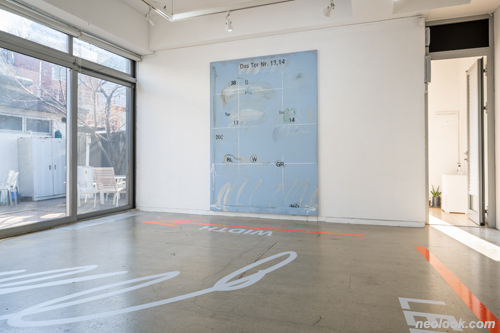- ● homepage
- ● archives
- ● restoration
- ● books
- ● big banners
- ● post board
- ■ neo's search
- ■ about us
- ■ 게재방법 안내
- 개인정보처리방침

- [email protected]
- Tel. 02_335_7922
- Fax. 02_335_7929
- 10:00am~04:30pm
- 월요일~금요일
- 3/3(월) 대체공휴일

통역된 그림들 Translated Paintings
권혜경展 / KWONHYEKYOUNG / 權惠景 / painting 2020_1204 ▶ 2020_1218 / 일요일 휴관
● 위 이미지를 클릭하면 네오룩 아카이브 Vol.20201016e | 권혜경展으로 갑니다.
권혜경 홈페이지_www.hyekyoungkwon.com
별도의 초대일시가 없습니다.
후원 / 문화체육관광부_서울특별시_서울문화재단
관람시간 / 10:00am~06:00pm / 일요일 휴관
스페이스 캔 Space CAN 서울 성북구 선잠로2길 14-4 (성북동 46-26번지) Tel. +82.(0)2.766.7660 www.can-foundation.org
통역된 그림들 ● 『통역된 그림들』은 이제는 만날 수 없는 원작 8점을 작가를 통해서 통역되어진 문자 혹은 기호의 코드를 통해서 관람자가 스스로 해석하고 새로운 방식으로 원작 없는 회화를 감상하는 전시이다. ● 더는 만날 수 없는 8점의 그림이 있다. 여러 가지 이유로 8점의 작품은 거래가 되었고 지금은 독일, 홍콩, 중국, 한국으로 뿔뿔이 흩어졌다. 작품을 보려고 하드디스크를 뒤적인다. 작품 하나하나가 떠오르며 멜랑콜리한 기분이 계속된다. 작품을 떠나보내는 이유는 다양하지만, 생활비를 위해 혹은 보관할 자리가 없어 마음의 준비도 없이 조급하게 떠나보낸 녀석들이 생각이나 가끔은 후회가 된다. ● 『통역된 그림들』에서는 만날 수 없는 작품 8점을 사진이 아닌 다른 방식으로 만나고 기억하고자 한다. 전시장에는 작품의 실체는 없으며 오로지 작가의 통역서를 보며 관람자 스스로 유추하여 원작을 감상해야 한다. 그동안 회화를 보여주는 새로운 방식의 시도에서 확장된 개념이라고 볼 수 있는 이번 전시는 기존의 원작을 넘어 각자의 상상으로 다시 그려지고 특별한 그림으로 만날 수 있기를 제안한다.

- 권혜경_통역된 그림들 Translated Paintings展_스페이스 캔_2020

- 권혜경_통역된 그림 #2_캔버스에 아크릴채색, 연필_250×180cm_2020
그림 통역 방법 ● 통역에는 6가지 규칙이 있다. 1. 캔버스의 정 중앙 위쪽은 제목을 표기한다. 2. 캔버스의 좌측과 아래쪽에 원작의 크기를 기재한다. 3. 원작에서 볼 수 있는 색은 영문 색상 약자로 함축하여 표기한다. 여기서 약자의 위치가 원작에서 보이는 대략 동일한 위치에 두는 것을 원칙으로 하고 어긋나면 화살표로 이동을 표시한다. 4. 캔버스 크기를 결정할 때 원작의 크기와 상관없이 자유롭게 결정할 수 있다. 5. 원작의 문구는 생략하거나 부분적으로 반영할 수 있으며 혹은 'TEXT'로 표기할 수 있다. 6. 작가의 감정을 이입한 터치나 즉흥적인 표현이 일부 허용된다. 위의 규칙들을 반영하여 사진 혹은 모니터로 원작의 이미지를 보며 간단하게 드로잉을 하고 이것을 준비한 캔버스에 옮긴다.

- 권혜경_통역된 그림들 Translated Paintings展_스페이스 캔_2020

- 통역된 그림 #4-1, #4-2, #4-3, #4-4_캔버스에 아크릴채색, 연필, 색연필_117×91cm_2020
통역된 그림 감상설명 ● 1. 통역된 그림과 약간의 거리를 두고 당신의 정면으로 보이도록 위치하세요. 2. 작품의 위쪽 중앙에 있는 알파벳은 원작의 제목입니다. 3. 작품의 좌측의 숫자는 원작의 세로크기, 아래쪽은 가로크기입니다. 4. 작품에 보이는 문자는 색상 약자나 원작에 있던 문자 일부입니다. <통역에 사용된 색상약자: B/BL검정, BG블루그레이, BR갈색, CR크림색, G/GR회색, GN초록, IN인디고, PK핑크, R레드, SI실버, W흰색, Y노랑> 5. 온 마음을 집중하여 문자/기호를 자유롭게 해석하여 원작의 이미지를 떠올려 보세요. ■ 권혜경

- 권혜경_통역된 그림 #1_캔버스에 아크릴채색, 연필_155×205cm_2020

- 권혜경_통역된 그림 드로잉 #5_모눈종이에 인쇄, 연필_25×18cm_2020
Translated Paintings ● Translated Paintings is an exhibition that invites to appreciate eight paintings, of which the original are no longer available. Instead, the original works are translated by the artist through letters or symbolic codes. The viewers can interpret on their own to comprehend the paintings in a new way without the original. ● There are eight paintings that I can no longer see. For various reasons, they are sold and now scattered over Germany, Hong Kong, China and Korea. I browse my hard disk to find their images. As I recall them one by one, melancholy persists in my mind. Due to financial needs or lack of storage space, I let each work go for a different reason. When I think of some particular piece that I let go hurriedly, I sometimes regret. ● In the exhibition Translated Paintings, the intention is to meet and remember the eight paintings that I cannot see anymore, in a way other than just a photograph. In the exhibition space, there is no physical presence of the original works. The viewers have to appreciate the original work through their analogy based on the artist's translation. This exhibition is an extended concept of my past attempts to show paintings in a new way. It suggests an experience for the viewers to meet the artworks and recreate a unique painting by their imagination beyond the original.
How to translate a painting ● The six rules of translation 1.At the top center of the canvas, write the title. 2.On the left side and at the bottom of the canvas, mark the size of the original work. 3.Note the name of the colors seen in the original work, with the English abbreviation. The position of the abbreviated color name should be basically at the same place as seen in the original, and if displaced, indicate the movement with an arrow. 4.The size of the canvas can be chosen regardless of the size of the original. 5.The texts on the original work can be omitted or partially reproduced in a translated version, or just marked as 'TEXT'. 6.Touches or improvised expressions reflecting the emotion of the artist are partly allowed. Observing the above-mentioned rules, the artist watches the image of the original work through the picture or the monitor, does the basic drawing, and then moves it to the prepared canvas.
How to appreciate a translated painting ● 1.Place yourself in front of a translated painting, facing the work and keeping a certain distance from it. 2.The alphabets at the top center of the work are the title of the original work. 3.The number on the left side of the work is the vertical length of the original work, and the one at the bottom is its horizontal length. 4.The letters written in the translated painting are either the abbreviation of the color names or a part of the text used in the original work. <The abbreviation of the color names used for the translation: B/BL-BLACK, BG-BLUE GREY, BR-BROWN, CR-CREAM, G/GR-GREY, GN-GREEN, IN-INDIGO, PK-PINK, R-RED, SI-SILVER, W-WHITE, Y-YELLOW> 5. Concentrate your entire mind, interpret the letters/symbols at your will and imagine the image of the original work. ■ Hye Kyoung Kwon
Vol.20201204e | 권혜경展 / KWONHYEKYOUNG / 權惠景 / painting

